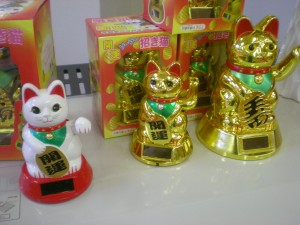 One more image taken in Japan recently by either Yuriko or Ann: some maneki neko at a gift shop not far from the base of Mt. Fuji. They’re the good luck cats that are nearly ubiquitous in Japanese retail establishments and are found in a lot of other places as well. We have one in our house on the same shelf as a few iterations of Spongebob, a pair of salt ‘n’ pepper penguins, a few painted eggshells, and the Ilanaaq figure I got in Canada, among other figurines.
One more image taken in Japan recently by either Yuriko or Ann: some maneki neko at a gift shop not far from the base of Mt. Fuji. They’re the good luck cats that are nearly ubiquitous in Japanese retail establishments and are found in a lot of other places as well. We have one in our house on the same shelf as a few iterations of Spongebob, a pair of salt ‘n’ pepper penguins, a few painted eggshells, and the Ilanaaq figure I got in Canada, among other figurines.
The origins of maneki neko are obscure. As this article by California antique dealer Alan Pate puts it, “Considering how accepted the cat has become, and how dear the image is to the Japanese, few people seem to know much about it. How has a seated cat become a symbol of good fortune and prosperity? What are its roots? Why do some have the left paw raised and others the right? Why are some white, some black, gold, or even red?
“Given the nature of folk traditions, evolving over time, absorbing elements of local beliefs and customs, we may never know the exact evolution of the maneki neko… A casual survey of antique dealers in Tokyo and Kyoto reveals many curious interpretations and theories: They originated in Osaka. No, they originated in Edo (old Tokyo). They originated in the 17th century. No, they most definitely originated in the early 16th century. The left paw is for wealth and the right for luck. No, the left is for a drinking establishment and the right for merchants. No, the left is for business and the right for home…”
I can’t shed any light on the subject. I just know I saw them a lot in Japan, and I asked some Japanese about it, and the best answer I got was that the cat grabs good luck for you and brings it in, as it might a fish or a bird.